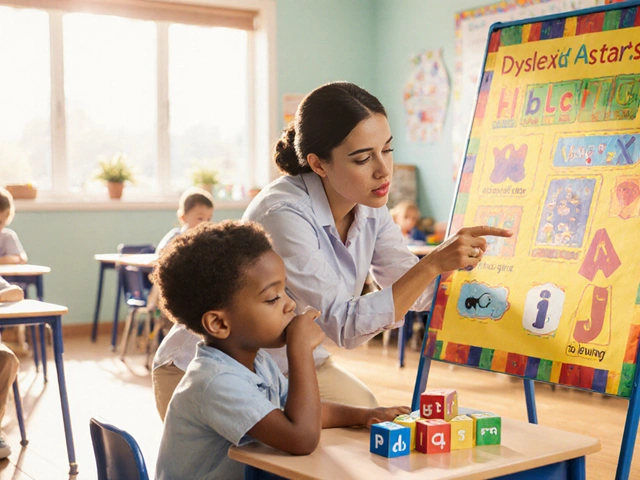Dealing with a stubborn special needs child can be like navigating a complex puzzle. Each piece brings its own set of challenges, but with patience and the right strategies, you can help your child thrive. First off, understanding why a child is being stubborn is crucial. Often, it's not just about defiance; it could be their way of expressing unmet needs or discomfort.
One key strategy is to focus on communication. Kids with special needs might struggle to express themselves verbally, leading to frustration. Encouraging alternative forms of communication, like using visual aids or sign language, can be incredibly beneficial. This way, you’re not only communicating with them but also empowering them to express their needs and emotions.
- Understanding Stubbornness
- Effective Communication Techniques
- Setting Boundaries and Expectations
- Positive Reinforcement Strategies
- Creating a Consistent Routine
- Managing Triggers and Meltdowns
Understanding Stubbornness
Being labeled as 'stubborn' isn't uncommon for kids, and it's something that can be even more pronounced in children with special needs. But what's really behind this behavior? It's important to look at it from a different angle. Stubbornness is sometimes a child’s way of asserting control in a world that feels overwhelming or unpredictable. It can also stem from difficulties in communication or sensory processing issues.
Understanding this behavior starts with recognizing that stubbornness is not an act of rebellion. For many special needs children, it can be a default response to change or a challenge they're not equipped to handle at that moment. This is not just a battle of wills; it's often a cry for help, something we can address with empathy and patience.
Spotting the Triggers
Many children might display stubborn behavior when confronted with situations they find stressful or unpredictable. Identifying these triggers is essential. Is it a crowded place? A certain sound or texture? For instance, if you notice your child resists leaving the house suddenly, it might not just be stubbornness—it could be anxiety about transitions. Recognizing these cues can significantly help in preventing and managing stubborn behavior.
The Role of Routines
Routine can be a powerful tool for reducing stubborn episodes. Consistent daily schedules create a sense of security and predictability, reducing anxiety and, consequently, stubbornness. Children with special needs often thrive on routine, as it helps make their world feel more manageable. So, having a fixed time for homework, meals, and bedtime can work wonders.
In some cases, offering choices within a routine can also help. For instance, allowing your child to pick between two outfits can give them a sense of control while still maintaining the structure they need.
Effective Communication Techniques
When it comes to connecting with a stubborn special needs child, communication is your golden ticket. It can make or break the relationship you're trying to build. But how do you make it work when words alone just don’t cut it?
Non-Verbal Communication
First, let's look at non-verbal communication. Kids with special needs might find it hard to express themselves verbally. Instead, they might rely on gestures, facial expressions, or even drawings. Sometimes they’ll use objects or actions to communicate what they want or need.
Pay close attention to these cues because they can tell you a lot about what’s going on in their mind. You might notice them picking up a toy and repeatedly placing it in a specific spot. This could be their way of saying something needs to change in their environment.
Visual Aids
Visual aids are another powerful tool. They can work wonders to bridge communication gaps. Why? Because they provide a straightforward way to show rather than tell. Visual aids could be simple picture cards indicating different activities, emotions, or requests. Start by making a visual schedule for daily activities. When used consistently, these aids can give your child a sense of control and help reduce stubborn behavior.
Using Technology
In today’s tech-savvy world, technology is no stranger to education and parenting strategies. Apps designed for communication can be quite handy. For instance, some applications use icons and images that kids can press to communicate their needs. Tablets or smart devices can also convert these icons into speech, allowing children to “talk” without actually talking.
Understanding Emotional Triggers
Recognizing emotional triggers is crucial. Every parent or educator has been there when a meltdown happens seemingly out of the blue. Understanding what triggers these emotional responses can make interacting with a stubborn child easier. Is it a certain sound? A specific situation? Once you identify these triggers, you can better manage them and offer more tailored communication methods.
Consistency and Patience
Overall, being consistent and patient is key. Repeat the same cues and remain patient when waiting for a response. Communication is not always about getting an immediate reply. It’s about creating a trusting environment where your child feels comfortable to express themselves.
Effective communication isn’t a one-size-fits-all solution, but trying out these techniques could make a noticeable difference. Tailor them to fit your child’s unique needs, and you might find that stubborn streak softening just a little.
Setting Boundaries and Expectations
When it comes to raising any child, but especially a special needs child, setting boundaries and clear expectations is essential. Why? Because it provides a sense of security and predictability, which can significantly help reduce stubbornness and tantrums.
Let's talk about making these boundaries stick. The key here is consistency. If you set a rule, like no screen time during meals, make sure it's a rule every day. Consistent boundaries help a child know what to expect and what is expected of them. This applies to everything from bedtimes to play schedules.
Understanding Flexibility Within Boundaries
While you need firm boundaries, there should be room for some flexibility based on the child's progress and needs. If they have had a tough day at school, maybe a little extra screen time won't harm.
- The boundary remains, but communication about exceptions is clear.
- You still maintain control without being too rigid.
Being Clear and Simple
When you're setting expectations, keep the message simple. Use clear, concise language that your child can easily understand. Instead of saying, "We need to improve our dining skills," say, "No playing during mealtime."
Use of Visual Aids
Visual aids can work wonders. Whether it's a daily schedule chart or visual cue cards, they help reinforce what's expected. This is especially useful if a child struggles with verbal instructions.
| Effectiveness of Visual Aids | Outcome |
|---|---|
| Increased Understanding | 80% of children show better comprehension |
| Reduced Meltdowns | Less frustration observed |
Remember, establishing boundaries is about creating a safe framework for your child to understand the world around them. Always reinforce the positive behavior when they follow the set rules. This creates a supportive environment where your child can grow, learn, and find comfort in structure.

Positive Reinforcement Strategies
Positive reinforcement is all about encouraging the good stuff. When your special needs child shows the right behavior, a simple but effective way to make sure it sticks is by acknowledging and appreciating it. This can be more powerful than you might think.
Catch 'Em Doing Good
Keep an eye out for positive behavior. It might be something small like sharing a toy or following a simple instruction. When you spot these moments, let your child know you're proud. A high-five, a hug, or even a sticker can go a long way. This shows them that positive actions bring positive results.
Use a Reward System
A reward system motivates your child by providing an incentive to behave positively. A chart with stars or stickers visible at home can be a fun and engaging way to mark achievements. Once they reach a certain number, they could earn a small prize. This system not only sets clear goals but also involves them actively in their progress.
Consistent Encouragement
Consistency is your ally. Make sure the structure of rewards is simple and predictable. This repetition helps the child understand exactly what is expected and what they will receive in return. It's important not to mix signals. If you say they'll get extra playtime for finishing homework, stick to it.
Acknowledge the Effort, Not Just Success
It's not just about meeting the goals but also valuing the effort, no matter how small. Encouraging the attempt itself helps build persistence and resilience. Maybe they didn’t get it perfect this time, but praising the hard work teaches them it’s okay to try and stumble.
| Behavior | Reward |
|---|---|
| Follows Instructions | Sticker on Chart |
| Completes Homework | Extra 10 min Playtime |
| Shares with Siblings | Favorite Snack |
Remember, the goal isn't to make the reward the focus, but to guide them toward understanding the value of positive behavior. This kind of reinforcement over time builds a sense of achievement and capability.
Creating a Consistent Routine
Consistency might just be your best friend when it comes to raising a special needs child. Kids with special needs often find comfort and predictability in routines. Without it, they might feel anxious or overwhelmed, leading to stubborn behaviors as a form of coping.
Routines help them understand what to expect and when to expect it. This predictability reduces anxiety and fosters a sense of security. Plus, let’s be honest, it makes life a little easier for you too!
Why Routines Matter
A study from the University of California found that children with autism spectrum disorders showed reduced anxiety and improved behavior when a consistent schedule was maintained. The predictability of routine allows their brains to focus less on coping with unknowns and more on engaging with the world around them.
Setting Up a Routine
- Start simple — Begin with daily activities like meals, bedtime, and schoolwork. Keep the routine realistic and attainable.
- Visual schedules — These are a game changer. A chart or visual timeline helps your child 'see' what comes next. It’s like a roadmap for their day.
- Be flexible — While consistency is key, life happens. Minor adjustments are okay and can teach your child resilience.
- Involve them — Let your child have a say in creating their routine when possible. It gives them a sense of ownership and can reduce stubbornness.
Maintaining the Routine
Maintaining the routine can be just as challenging as setting it up. Here are some tips:
- Consistency across environments — Try to keep the same routine at home, school, and any other regular settings.
- Communicate changes — If a change is unavoidable, communicate it clearly and calmly. Give your child time to adjust to the idea.
- Positive reinforcement — Celebrate small victories when they stick to the routine. Positive reinforcement plays a crucial role in reinforcing these habits.
Creating and maintaining a routine can transform the way your stubborn child interacts with the world. It provides structure and reduces stress, allowing both you and your child to focus on growth and learning.
Managing Triggers and Meltdowns
If you've ever felt like you're walking on eggshells around a stubborn special needs child, you're not alone. Understanding and managing triggers is essential to preventing those dreaded meltdowns. First, it helps to identify what sets off their stubborn behavior. It could be specific sounds, crowded places, or even something as simple as a change in routine.
Identifying Triggers
Start by keeping a behavior diary. Note when the stubbornness or meltdowns occur and what was happening just before. Over time, you'll likely spot patterns. For instance, does transitioning from one activity to another lead to outbursts? Or perhaps certain events like family gatherings or shopping trips?
Creating a Calm Environment
Once you've pinpointed potential triggers, aim to create a more accommodating environment. This could mean reducing noise levels with noise-cancelling headphones or setting up a quiet corner in your home where your child can retreat when things get overwhelming. Remember, a calm environment can make a world of difference.
Planning and Preparing
Prior preparation can go a long way in preventing meltdowns. If you know a trigger is unavoidable, like a medical appointment or a family event, prep your child in advance. Explain what will happen in simple terms, maybe even using visual schedules or social stories. Knowing what to expect can ease anxiety.
Strengthening Coping Skills
Teach coping skills suited to your child's needs. For some, deep breathing or counting can help, while others might benefit from sensory activities like playing with kinetic sand or squeezing a stress ball. Incorporating these into their daily routine can help them manage emotions better.
Empathy plays a big role too. Acknowledge their feelings. Say things like, "I see you're upset, and that's okay." This can help them feel understood and less isolated.
Handling special needs and meltdowns means being proactive and adaptable, helping you and your child to navigate their emotions and actions together.






